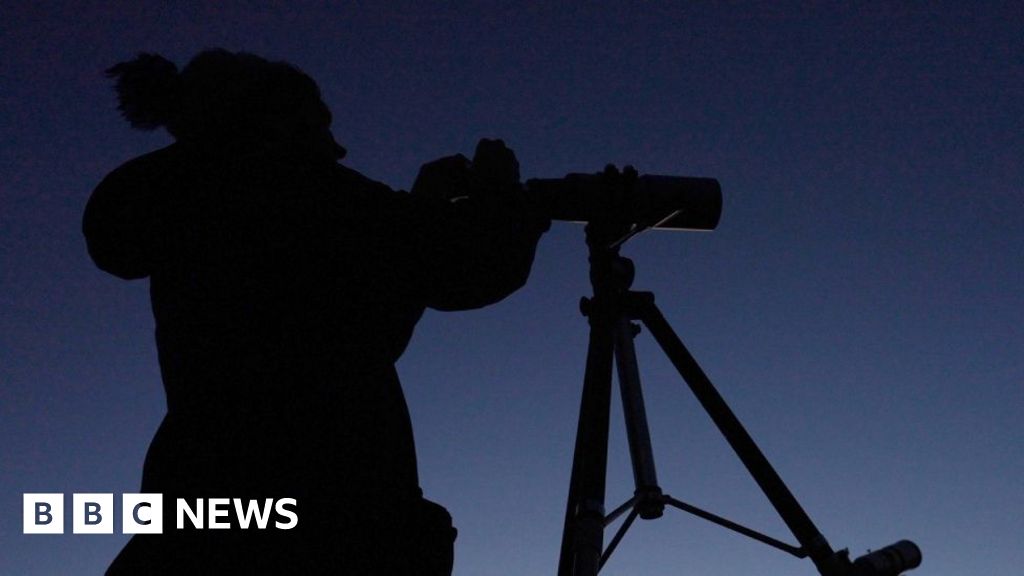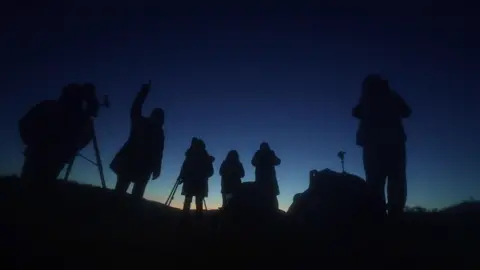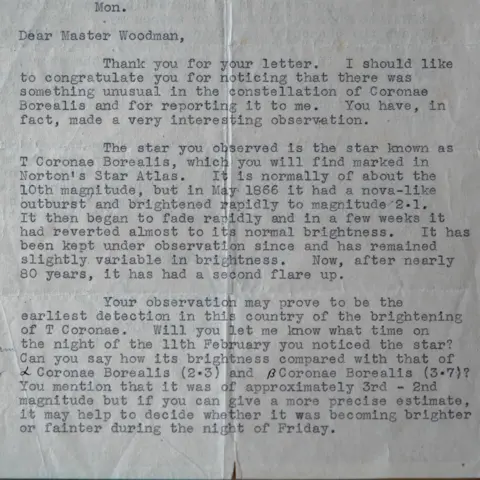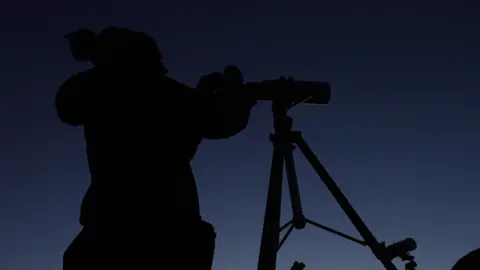
 BBC/Tony Jolliffe
BBC/Tony JolliffeOn a cold February night in 1946, a 15-year-old schoolboy made a surprising discovery as he peered out of his bedroom window.
Michael Woodman, a keen amateur astronomer from Newport, had stayed up late waiting for his father to come home when he noticed something strange in the night sky.
“There was the constellation of Corona Borealis, but in the ring of the Corona, the second star down was bright – very bright,” he explains.
“And I thought ‘I’ve never seen anything like that before.'”
 BBC/Tony Jolliffe
BBC/Tony JolliffeThe next morning he wrote to the Astronomer Royal. The now 94-year-old smiles as he recalls the memory, surprised that his teenage self would be so bold.
“And bless me if the Astronomer Royal didn’t reply, with a letter I’ve still got.”
Michael Woodman had witnessed a rare celestial event that briefly dazzled the heavens. Not only that, the Astronomer Royal informed him that he was the first person in the country to have seen this.
He’d spotted a star system, about 3,000 light years away, called T Corona Borealis – or T Cor Bor for short – exploding into brightness, becoming visible in the night sky for a few short days.
“I hit the jackpot,” he says.
 BBC/Tony Jolliffe
BBC/Tony Jolliffe BBC/Tony Jolliffe
BBC/Tony JolliffeHow to look for T Cor Bor
Now a whole new generation of stargazers are scanning the skies again because scientists believe T Cor Bor ignites about every 80 years or so.
On a crystal clear night, in the Dark Skies Reserve of Bannau Brycheiniog, also known as the Brecon Beacons, astronomers are setting up their telescopes.
“T Cor Bor is dim at the minute – it’s magnitude 10, well below what you can see with the naked eye,” explains Dr Jenifer Millard from Fifth Star Labs.
To find the area of sky where it should appear, she advises to first locate the plough and follow its handle to Arcturus. To the west of this star is the curved constellation of Corona Borealis, made up of seven stars, and where T Cor Bor will at some point light up.
“It is only going to be visible to the naked eye for a couple of days,” she says.
“Of course, if you’ve got a small pair of binoculars or a small telescope, you’ll be able to see it for a little bit longer because you’ve got that magnifying tool. But I do think that it is the short stint in the sky that makes it really special.”

The astronomical phenomenon is caused by the interaction between two stars orbiting each other.
A small white dwarf, which is a dead star, is locked in a cosmic dance with a much larger red giant – a star that’s reaching the end of its life.
The compact white dwarf has an immense gravitational pull, so great that it steals material away from its larger neighbour.
“The gravity on the surface of the white dwarf is a million times the gravity we feel on Earth, so if we stood on it, we would be crushed instantly,” explains Dr Jane Clark, from the Cardiff Astronomical Society.
Over time, the material it grabs from the other star gets crushed and compressed – until eventually it triggers a nuclear explosion, releasing a huge amount of energy – a process known as going nova.
“And when that happens, it will shine like the best Christmas tree in town,” says Dr Clark.
 BBC/Tony Jolliffe
BBC/Tony JolliffeAstronomers think this process happens on repeat, with an outburst from T Cor Bor occurring about every 80 years.
But there aren’t many records of this. And there have already been a few false alarms that T Cor Bor was about to appear – followed by a disappointing no show.
But Dr Chris North from Cardiff University says astronomers around the world are poised to catch the light show, which will allow them to study this star in more detail than ever before.
And he’s hopeful it could appear soon.
“It seems that in the past, this has dimmed a little bit before it’s actually erupted, and there are signs that maybe, at the moment, it’s just dipping a little bit in brightness,” he says.
“So maybe that’s a hint that it’s getting close to its eruption.”
Michael Woodman certainly wants to see T Cor Bor again.
“Somebody will get me into a car and drive me out into the wild somewhere so I can have a decent look. That’s what we are hoping for,” he says.
And if he catches another glimpse of the light show, he believes it will put him in a very exclusive club – of just one.
“Eighty years on, we’re all looking at the skies again, not only me, but the whole world apparently,” he says.
“If I’m alive, if I see it, I will be the only one who’s seen it twice.”
Then with a big broad smile and a little chuckle, he adds: “Got to keep breathing!”

